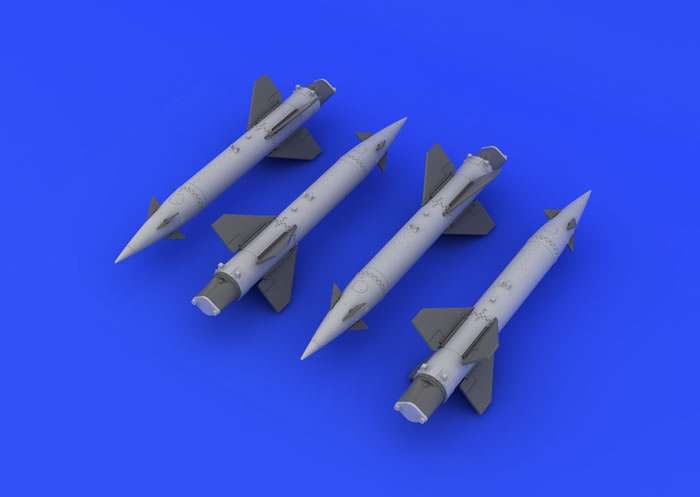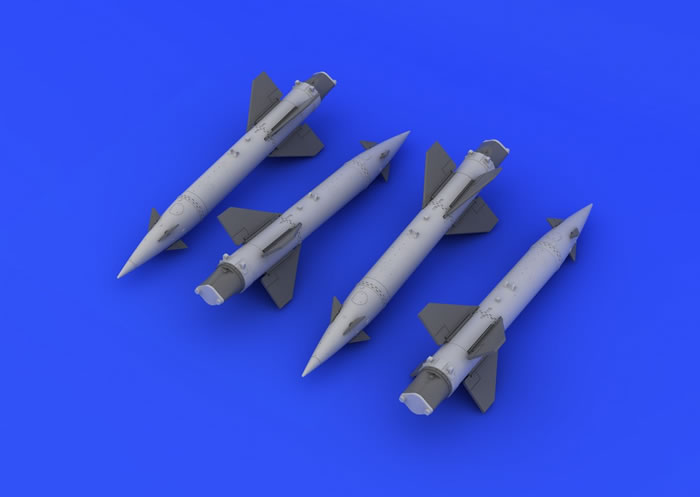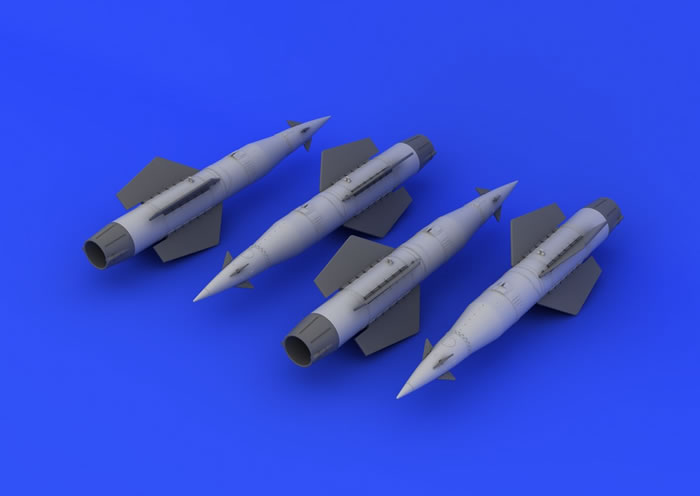AGM-12 Bullpup Missiles
 (CAD illustration courtesy of Eduard website) (CAD illustration courtesy of Eduard website)
Eduard BRASSIN, 1/48 scale
S u m m a r y : |
Catalogue Number |
Eduard BRASSIN Item Nos.
648 163 - 1/48 AGM-12B Bullpup A
648 164 - 1/48 AGM-12C Bullpup C |
Contents and media |
Single decal sheet, single double sided instruction sheet. 44 resin items per set. |
Scale |
1/48 |
Price: |
USD14.95 plus shipping available online from Eduard’s website |
Review Type |
First Look |
Advantages: |
Eduard continuing the tradition of well produced and high quality ordnance sets. Well cast, easily built and painted and decal. |
Disadvantages: |
None noted. |
Recommendation: |
Another welcome addition to Eduard’s growing ordnance sets. This is a simple kit to add some visual interest to a model. |
Reviewed by Mick Drover

Eduard's 1/48 scale MiG-21R Interior is available online from Squadron.com
The AGM-12 Bullpup is an air-to-ground missile which was used on the A-4 Skyhawk, A-6 Intruder, F-105 Thunderchief and F-4 Phantom among others. It has been superseded by more advanced weapons, notably the AGM-62 Walleye and AGM-65 Maverick.
The Bullpup was the first mass-produced air-surface command guided missile, first deployed by the United States Navy in 1959 as the ASM-N-7, until it was redesignated the AGM-12B in 1962. It was developed as a result of experiences in the Korean War where US airpower had great difficulty in destroying targets which required precise aiming and were often heavily defended, such as bridges.
The Bullpup had a Manual Command Line Of Sight guidance system with roll-stabilization. In flight the pilot or weapons operator tracked the Bullpup by watching a flare on the back of the missile and used a control joystick to steer it toward the target using radio signals. It was initially powered by a solid fuel rocket motor, and carried a 250 lb (110 kg) warhead.
After launching the Bullpup, best accuracy was maintained by continuing to fly the same track, so that the pilot could sight down the smoke trail and steer the missile from directly behind as much as possible. Unfortunately, one problem quickly discovered by pilots in Vietnam was that gunners on the ground could simply fire at the smoke trail of the missile's flare and have a fairly good chance of hitting the aircraft that had launched—and was still guiding—the missile. Thus, to try to protect their own aircraft, the pilot would "jig" slightly off of the missile's path and hopefully avoid the anti-aircraft fire.
Source: Wikipedia
Cast in light and dark grey resin, the four AGM-12B Bullpup missiles packed in Eduard’s standard blister pack are up to their usual high standard of production. To compliment each missile, a full set of stencils is provided on a single decal sheet. Each missile is broken down into the missile body, individual front and rear guidance fins, motor housing and engine cover. Casting quality is excellent with rivets and panel lines reproduced in exquisite detail and the attachment points to the pour plugs shouldn’t prove to be any problem when removing the parts. The tips of the warheads will need a small amount clean up to bring them to a sharp point. Fore and aft guidance fins are supplied to a suitable scale thickness too and as with Eduard’s usual forethought, a rear engine cover is also provided should you wish to build them with covers applied. Standard Eduard instructions are provided. The -12B version can be viewed here and the -12C version can be viewed here.
AGM-12B
 (CAD illustration courtesy of Eduard website) (CAD illustration courtesy of Eduard website)
AGM-12C
 (CAD illustration courtesy of Eduard website) (CAD illustration courtesy of Eduard website)
The later version of the Bullpup, the AGM-12C is also available from Eduard under item number 648164. The difference being the larger and longer one thousand pound warhead used for armour piercing, and the longer chord wings.
These new 1/48 AGM-12 Bullpup missiles from Eduard will certainly add some visual interest to your Vietnam era aircraft. Loaded on a F-4 Phantom or F-105 they will certainly look the part. Highly recommended for those looking to ‘load up’ their next 1/48 scale jet project.
Recommended.
Thanks to Eduard for the samples and images.
Review Text Copyright © 2015 by Mick Drover
Page Created 2 March, 2015
Last updated
2 March, 2015
Back to HyperScale Main Page
Back to Reviews Page

|
